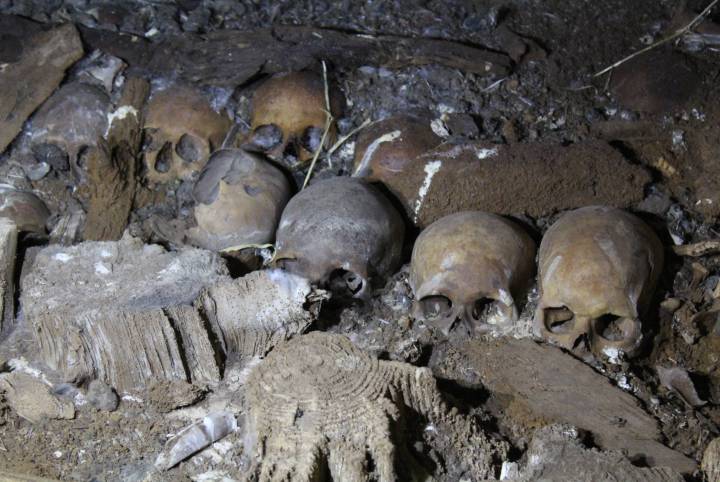The Biniadrís cave is a forgotten cavern in the rock that hadn’t been touched for thousands of years. In an almost inaccessible hole in the rock face, measuring just 10 square meters were a great number of human skulls covered with dirt. Some had a perfect orifice drilled into the cranium, indicating that they had been trepanned.

The cave was discovered in 2013 in the island of Menorca in the Balearic Islands. So far, the archaeological team has identified the bones of around 100 people belonging to the island’s Talayotic period during the Bronze Age. The cave was used from around 3,300 years ago until around 2,600 years ago as a burial site – “a sacred space” where mysterious funeral rituals were carried out.
However, they don’t know how they got the bodies to the cave but it appears that they were wrapped in a kind of linen shroud and carried on their backs. They were placed in the centre of the cave, covered with red ocher and left there until they had to make room for another body. Then the old remains would be piled up against the sides of the cave.

The archaeological team which has just published the first results of their research has photos of one of the most impressive discoveries in Biniadrís: a perfectly preserved lock of hair dyed with red ochre powder. They would cut a lock of hair from the dead and placed it in a tube that was made of leather or wood or other materials. In the lids of these tubes, which were made of bones, they carved a series of almost perfect concentric circles. However, it’s impossible to know what these ceremonies meant to them. In the same period, the Assyrians worshipped Enki, the god of fresh water; and the Egyptians worshipped Osiris, god of the afterlife. Like thousands of other beliefs that prompted generations of wars, they no longer mean anything.
The archaeologists have also discovered buttons made of bone in the cave, similar to those from a duffel coat that suggest that the bodies were dressed. The buttons were pieces of craftsmanship that were perhaps passed down from generation to generation, according to archaeologist Manuel Altamirano.
In their report, the team describes five trepanned skulls bearing practically perfect holes. Some of these holes are scarcely big enough to fit a pencil through while others are as big as three centimetres in diameter. The lips of the holes suggest that the bone regenerated after the operation and the individuals subjected to the surgery carried on living. Trepanation was a common medical operation dating back to Neolithic times, undertaken to relieve the pressure of meningitis or strong headaches. The trepanations were performed by people with a certain know-how. According to the archaeologists, they made the holes with a stone tool using it like sandpaper and then employed a point. They would have had some kind of painkiller to avoid the pain.
The Biniadrís cave is the last mysterious corner of the funeral territory known as the Cales coves in the Alaior region of Menorca where, in 1990, other caves were found containing evidence of similar burials, such as Es Mussol, Es Càrritx and Es Pas. But, even within this extraordinary framework, Biniadrís is exceptional due to the quality of the remains. The digs will continue next summer – the cave still has much to reveal about the trepanned redheads.